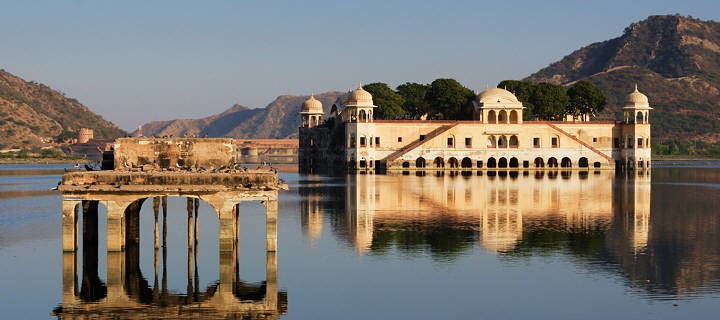About Jaipur and How to Reach
It was founded in 1727, by the Kachwaha Rajput Ruler Sawai Jaisingh II, who was the king of Amber. Jaipur the capital of Rajasthan is popularly known by the nickname ‘Pink City of India’ which is because of the distinctive saffron or pink shade of the buildings. The capital of Rajasthan, Jaipur is immersed in culture and history. Individuals from all parts of the world come to observe the beauty and to think about the cultural legacy of Jaipur. The planning of the city was done according to the Vedic Vastu Shastra. The well-planned streets and detailed and artistic architecture make it one of the top preferred tourist locations.
Amber Fort and Palace

Situated at the foot of the Aravalli range and overlooking the Maota Lake, the Amber (Amer) Fort is popular for its artistic artisanship that is laid on a four-level layout. It is one of the greatest places to visit in Jaipur and is a fine example of red sandstone and marble architecture comprising the Hall of Public Audience, Sheesh Mahal, Hall of Private Audience, and Sukh Niwas. Established in the 16th century by Raja Man Singh I, the Amber Fort within its ramparts holds a rich blend of Hindu elements including several gates and cobbled paths and the Sheela Mata Temple. Today the Amber Fort captures the mind of millions of tourist from everywhere the world and the major tourist attraction remains the light and sound show that is held at Kesar Kyari inside Amber Fort every evening. Another mind-boggling display that you shouldn’t miss is when the fort is drenched in honey-gold at sundown.
Jaigarh Fort

Often dubbed as Victory Fort, the Jaigarh Fort was established in 1726 by Jai Singh II to protect the Amber Fort, which lies at the foot of the Cheel Ka Teela. One of the most important highlights of the fort is the grand canyon, “Jaivana”, which was then the world’s largest cannon on wheels. The fort is crafted with a complex network of subterranean passages and comprises the Aram Mandir, Laxmi Vilas, Vilas Mandir and Lalit Mandir. Today the fort museum displays a wide range of antiques and armors belonging to several Rajput clans.
Nahargarh Fort

All over the pink city of Jaipur, the Nahargarh Fort is perched on the edge of the Aravalli Hills. Established in 1734 as a summer retreat by Maharaja Sawai Jai Singh II… the fort was later extended by Sawai Ram Singh in 1868 and between 1883 and 1892 several palaces, including the Madhavendra Bhawan, were ramped up by Sawai Madho Singh. The extended walls of the fort attach the Jaigarh Fort. Throughout its history, the fort maintained its lifelike structure as it never witnessed any attacks BUT was a hideaway to the British army during the Indian Rebellion of 1857 (Indian Sepoy Mutiny OR Indian Mutiny of 1857). Today it is one of the favorite tourist hangouts in the outskirts of Jaipur with the major attraction being the panoramic view of the Jaipur city and the step well. Within the fort complex, there is a museum that displays a great collection of armors and paintings. It also maintains a little rooftop restaurant where you can chill out for long hours.
Hawa Mahal

Located in the heart of the bustling city of Jaipur, the Hawa Mahal is one of the important historical landmarks in India that reveal a rich cultural and architectural heritage with a fusion of Rajasthani style of architecture and the Islamic Mughal architecture. Established in the 18th century by Maharaja Sawai Pratap Singh… it is an outstanding work of red and pink sandstone popular for its high screen wall, which resembles a honeycomb web of a beehive, with several windows for the ladies of the royal household who could observe street festivities while unseen from the outside. The Hawa Mahal or the Palace of Winds comprises more than a thousand windows decorated with intricate latticework, rooms inlaid with colorful marbles, domed canopies, fluted pillars having the lotus and a courtyard, and floral patterns that now houses a museum.
City Palace

With a fusion of the typical Rajasthani style of architecture, European architecture and Mughal architecture. the City Palace stands graceful in the heart of the pink city of Jaipur. It is one of the Famous tourist sites and holds an important place in Rajasthan Tourism because of its exquisite architectural work and historical significance. The City Palace, which was established in 1732 by Maharaja Sawai Jai Singh, comprises several gateways – Virendra Pol, Udai Pol, and Tripolia; small places which include the Maharani Palace, Mubarak Mahal, and Chandra Mahal; Pitam Niwas Chowk, which is a courtyard; and halls including Diwan-I-Khas and Diwan-I-Aam. The Baggi Khana, which is now a museum, is well stocked with a collection of old carriages, palanquins, and European cars. The palace also houses a temple that is dedicated to Lord Krishna.
Wonderful Tourist Places to Visit In Bikaner
Jal Mahal

Situated in the midst of the Man Sagar Lake, the Jal Mahal is another amazing example of the graceful Rajasthani style of construction and Islamic style of architecture. Built in the 18th century by Maharaja Jai Singh II of Amber, the Jal Mahal is a five-storied red sandstone structure with some delightful chhatris, intricately decorated rooms, hallways and wall paintings detailing the complex Rajasthani art. The Jal Mahal over the years has gone through several restorations along with lake and the dam close too. The region surrounding the Jal Mahal holds a large biosphere with the Aravalli range encircling and layered with tropical forest that is a home to varied species of flora and fauna. Tourists going by the Jal Mahal can take a boat ride in the Man Sagar Lake. The boats here are crafted in particularly Rajasthani style.









